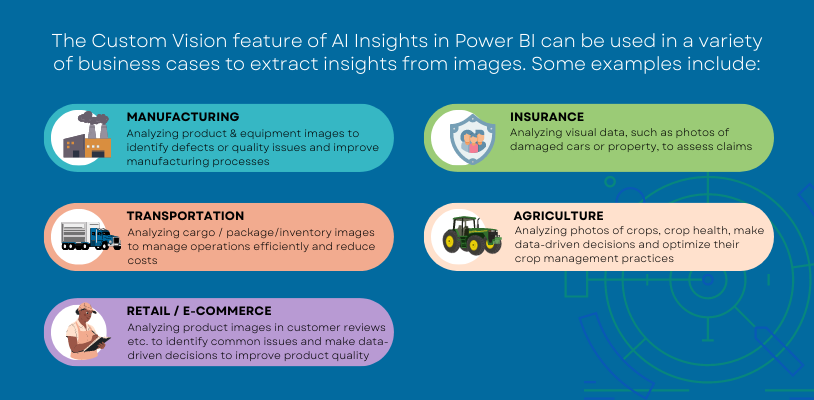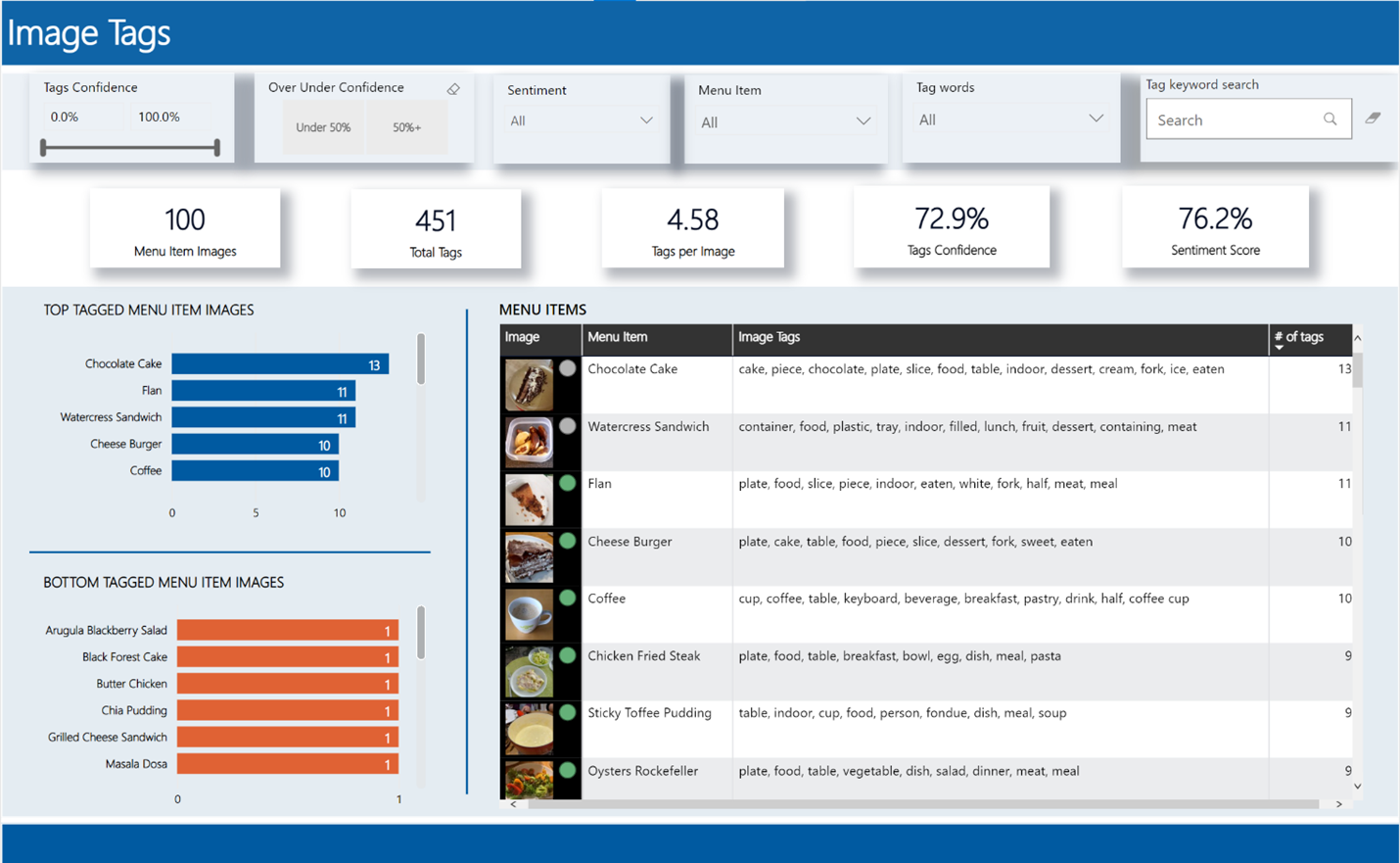Modern analytics and business intelligence (ABI) platforms leverage AI to generate automated insights and enhance decision-making in critical business areas, such as sales, marketing, and operations. By enabling more advanced data analysis, visualization, and prediction capabilities, AI has the potential to revolutionize the way organizations understand their customers, operations, and markets, ultimately leading to better performance and competitive advantage.
As highlighted in Part 1 of this series, Microsoft has been acknowledged by Gartner as a leading provider in this field for their Power BI solution, which includes characteristics like data preparation, exploration of data through visuals, and the use of interactive dashboards and augmented analytics. AI Insights is a feature that enables augmented analytics by leveraging advanced AI and machine learning capabilities to analyze and derive insights from data. By automating and streamlining the data analysis process, this feature simplifies the task of extracting insights from data, making it more accessible to end users.
AI Insights: Bringing AI into PBI
The Microsoft AI portfolio contains a wide range of products and services to help organizations develop, implement, and manage AI solutions. It includes Azure Cognitive Services- a collection of pre-built APIs for natural language processing, computer vision, speech recognition, and more. It is possible to use these Cognitive Services with Power BI to enhance your reports by adding advanced AI capabilities like natural language processing, image, and speech recognition. There are two ways you can do this.
Option #1: Create an Azure subscription, create a Cognitive Services resource, get an API key, and use Power Query to connect to the API, retrieve data and create visualizations in your Power BI report. While this option provides the opportunity to bring in several AI capabilities to Power BI, we would recommend it only if you are able to work with the APIs directly.
Option #2: Use Power BI's AI Insights feature to apply certain cognitive services that are “natively integrated” with Power BI. In other words, AI Insights in Power BI, by virtue of its integration with other Microsoft AI services like Cognitive Services and Azure Machine Learning, has several features that allow users to directly analyze and gain insights from their data. We covered Text Analytics in Part 1 of this series. Let’s deep dive into Custom Vision.
Custom Vision: Features & Use Cases
Custom Vision allows you to use prebuilt models and train it using a set of images. Once the model is trained, it can be used to analyze new images and extract valuable information. The output is a set of tags that correspond to how the images were classified. This streamlined approach allows you to extract valuable insights quickly and easily from image data, without having to worry about the complexities of machine learning. This data can then be integrated seamlessly into Power BI reports and dashboards, providing a visual and interactive way to gain insights from image data. With these visualizations, it's possible to quickly spot trends and patterns in the data, enabling more informed decision-making.
The Custom Vision feature of AI Insights in Power BI can be used in a variety of business cases to extract insights from images. Some examples include:
Manufacturing industry - Manufacturing companies often have a large amount of visual data, such as images of products or equipment, that they need to analyze. Custom Vision in AI Insights can help to analyze these images, allowing the organization to identify defects or quality issues and improve their manufacturing processes quickly and accurately.
Insurance industry - Insurance companies often need to analyze visual data, such as photos of damaged cars or property, to assess claims. Custom Vision in AI Insights can help to analyze these images, allowing the organization to process claims and provide better customer service quickly and accurately more efficiently.
Transportation industry - Transportation companies, such as airlines or shipping companies, often use visual data, such as images of cargo or packages, to track and manage their inventory. Custom Vision in AI Insights can help to analyze these images, allowing the organization to manage its operations and reduce costs quickly and accurately.
Agriculture industry - Agricultural companies often use visual data, such as satellite images or photos of crops, to monitor crop health and estimate yields. Custom Vision in AI Insights can help to analyze these images, allowing the organization to make data-driven decisions and optimize their crop management practices quickly and accurately.
Retail/ E-commerce - E-commerce companies can use visual data, such as product images in customer reviews, to analyze and categorize customer feedback. Custom Vision in AI Insights can help to analyze these images, allowing the organization to identify common themes and issues quickly and accurately in customer feedback and make data-driven decisions to improve product quality and customer satisfaction.
These are just a few examples, but the potential use cases for the Custom Vision feature of AI Insights are vast and can be applied to many industries and scenarios. We will discuss one such use case in the next section.
Custom Vision PoC: Revolutionizing Restaurant Menus with AI
Recently, we created a PoC for a restaurant business to analyze images and extract insights using Custom Vision.
A restaurant business could use this in several ways-
- Menu Item Recognition: Recognize different menu items from pictures of dishes. This can be used to identify the most popular menu items and adjust the menu accordingly.
- Food Quality Analysis: Recognize the quality of the food from pictures of dishes, such as over or undercooked, and identify areas for improvement.
- Table Setting Recognition: Recognize the cleanliness and presentation of table settings, which can be used to identify areas for improvement in the restaurant's service.
- Table Occupancy Recognition: Recognize the occupancy of tables to optimize the table allocation and reduce wait time for customers.
- Staff Recognition: Recognize the staff members and monitor their performance, such as the cleanliness of their uniforms.
- Branding and Promotion: Recognize the branding and promotion of the restaurant, such as banners or signs, to monitor their performance and identify areas for improvement.

Figure: Restaurant Analytics Dashboard powered by Custom Vision in AI Insights
One of our early learnings was that the service expects images to be in a binary format. If the images are available online, the corresponding URLs for each image can instead be imported within the function as binary. There is no need to write any M code or understand the inner workings of the ML models before calling the function. Though we did write some DAX formulas to better visualize the results.
Custom Vision relies heavily on machine learning algorithms, which in turn require large amounts of high-quality training data to accurately classify and recognize images. It's important to ensure that the training data is representative of the images that will be analyzed in the real world, and that it is properly labeled and annotated. That said, we see that the feature works best with a limited number of images. The introduction of very large datasets of binary images can result in very slow performance. For large datasets, we suggest breaking them down into smaller sets.
We also noticed that Custom Vision tags not only the main image it detects but the surroundings too. Therefore, it is not unusual to have several tags for one image. Some of the tags might seem irrelevant, but you can still extract valuable insights from those. For each image, a set of comma-separated tags are returned. An additional column with each individual tag is also returned. What this means is that custom vision introduces a lot of duplicate tags. Another implication is that the size of the dataset can easily increase. A valuable feature though is the confidence level it returns with each tag.
Business Outcomes
Custom Vision in AI Insights of Power BI can help businesses gain valuable insights from image data, improve efficiency, and uncover new opportunities for growth.
The business outcomes of using AI Insights in Power BI with Custom Vision can vary depending on the specific use case, but some examples include:
- Improved data analysis: By being able to extract information from image data, businesses can gain a more comprehensive understanding of their operations and make better-informed decisions. E.g., analyze images of vehicles in transportation and identify patterns in maintenance and repair needs to improve fleet management and reduce costs.
- Automation of manual processes: By automating the process of extracting information from images, businesses can save time and resources that would otherwise be spent on manual data entry. E.g., Improving manufacturing processes by identifying defects and variations in products
- Increased efficiency: By using image recognition to quickly identify and classify objects in images, businesses can streamline processes and increase productivity. E.g., Optimizing inventory management by identifying patterns in product images
- New revenue streams: By using image recognition to identify patterns and trends in image data, businesses can uncover new opportunities for revenue generation. E.g., Analyze images of properties in real estate, identify popular features among buyers, and inform property renovations and marketing efforts to increase sales.
Summary
Artificial Intelligence (AI) features in ABI platforms like Power BI can significantly enhance the capabilities of data analysis and visualization. These features can allow for more advanced and automated data processing, such as natural language processing, image recognition, and predictive analytics. This can save time and resources for businesses by automating tasks that would otherwise be done manually and can also provide more accurate and detailed insights into data.
We recommend using Custom Vision in AI Insights when an organization has a large amount of visual data, such as images or videos, that they want to analyze. That said, custom Vision in AI Insights requires a significant amount of visual data to train the machine learning model. If there is a limited amount of visual data available, or the data is of poor quality, the model may not be accurate or effective. In such cases, other data analysis techniques may be more suitable. It works best with visual data that is relatively simple and easy to classify.
Overall, we see Custom Vision in AI Insights as a powerful tool for visual data analysis. For the right use case, businesses can gain insights from image data in ways that were previously difficult or impossible.
Unlock the full potential of your data with AI Insights in Power BI with our expert team's help. We can help you gain the advantage of extracting valuable insights from your data, providing you with actionable results to drive growth and success for your organization.
In our PoC, we explored how the Custom Vision feature of AI Insights in Power BI, could help a restaurant business to analyze images and extract insights to improve the overall performance of the restaurant, such as food quality, service, and customer experience.
Contact us today to learn more about how AI Insights in Power BI can benefit your business.

